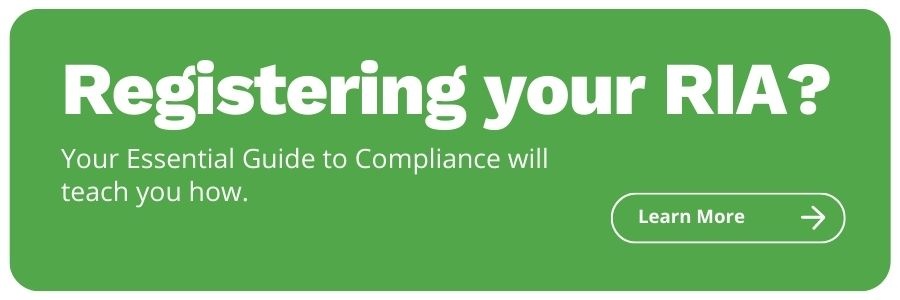Adjusting Your Compliance Program for a TAMP
Share this
One of the more daunting tasks for a financial planner is to determine how to integrate investment management services into a financial planning practice. Many fee-only RIAs focused on financial planning may find the need to charge based on assets. In this situation, using a TAMP can fill the gap, so let’s take a look at the compliance perspective and process of adjusting your compliance program for a TAMP.
What is a TAMP?
A TAMP is a turnkey asset management program that utilizes technology to provide a technology platform for financial advisers to provide asset management services, with the goal of greatly reducing the amount of time advisers spend on portfolio management and investment research. Many TAMPS also offer other services, such as back office operations, performance reporting and billing services.
Who are TAMPS best for?
TAMPS are widely considered to be most suitable for financial planning-focused advisors who are not interested in executing trades on an account-by-account basis, or spending extensive amounts of time doing portfolio management and investment research. By trend, fee-only financial planners are finding that fulfilling their fiduciary responsibility to their clients involves more than simply managing their assets. Instead, taking a more holistic look at the client’s entire financial picture is considered to be a more responsible approach. From a compliance standpoint, the more trading activity an RIA executes on a daily basis, the more strenuous the compliance supervision requirements can become. As a result, it can greatly simplify the compliance responsibility to supervise trading activity, using models that are compiled and provided by a TAMP.
Trade Review and Supervision Practices
All firms are required to have supervision over their trading activities. For firms that trade in their client accounts and have both discretionary and nondiscretionary asset management, the responsibility extends to being able to separate trades as such, on an individual basis. This means, for every trade, it either needs to be marked as discretionary, or there needs to be documentation in the firm’s CRM that specifies the date and time the client authorized the order. In addition, a conversation may arise in an audit or examination as to how the advisor determined the individual security that was purchased or sold and how it constitutes a suitable recommendation as it pertains to the client’s risk profile, investment policy statement (IPS), or suitability profile. This can be a burdensome requirement.
With a TAMP, the compliance supervision process can be simplified. Rather than proving suitability on a “per trade” basis, advisors can simply provide a regulator with commentary on how the “model” that was selected and how it is suitable for the client. Once the model is selected and suitability is established, the TAMP takes care of the individual trades, relieving the advisor of the daily responsibility of having to show a paper trail on each trade. Also, most TAMPS require the advisor to take on discretionary trading access for client accounts. This accomplishes the goal of removing the requirement of the advisor to designate individual trades executed within the model of the TAMP, as discretionary or nondiscretionary. The advisor no longer has to document a note in the CRM each time a trade is placed. Instead, the advisor only documents account reviews and client meetings in which the suitability of the model is discussed. However, it is important to note: compliance officers still have the responsibility to maintain and review trade blotters on a monthly basis. Reason being, although the TAMP is executing the trades, there still may be some questions in an audit or examination about suitability and supervision practices that the CCO will want to be prepared to answer.
Addiction to the AUM Model
Like it or not, assets under management as a primary focus of advisory services is a staple of the industry. Nearly all of the securities regulations adopted by both the SEC, and state regulatory agencies, are based on AUM. This creates a compliance dilemma for firms that want to focus on financial planning. How does a firm that is primarily financial planning-focused provide asset management services without being consumed by the time it takes to manage portfolios? This is where a TAMP comes in. An effective TAMP will not only provide these services, but will also assist the advisor in understanding the process so that the CCO can effectively communicate with regulators about the trading practices.
Understand the flow of fees and payments
Quite often, advisors become confused about the various payment options offered by TAMPs. Questions surrounding the timing of payments, whether or not the TAMPs’ fee will be passed onto the client or paid by the firm, the value of the portfolio that will be used to calculate the fee, the timing of payments, and the practices of the custodian as it pertains to fee withdrawals and invoices, are all items that should be clear prior to working with a TAMP. Other considerations are how the TAMP can, or cannot, work in conjunction with a WRAP program, and asset-based vs.transaction-based pricing procedures. It is critical there be a strong understanding of these items before completing the fees and compensation section of form ADV Part 2A Item 5.
Become familiar with the Models
To a previous point, although advisors can hand off the day-to-day trading responsibilities to a TAMP, there still may arise the need for a conversation that reflects the advisor’s understanding of the assets that are being traded in their clients’ accounts. Since the advisor is assisting the client in selecting the appropriate model based on suitability, the advisor will need to understand the assets that are being traded in the model, in order to justify their recommendation. This includes knowledge of basic security types such as stocks, bonds, mutual funds and ETFs, how these items are priced or valued, and how market volatility can impact the value of each security type. An effective TAMP will provide resources for the adviser to gain knowledge and understanding of the models they will be recommending to their clients.

About the Author
Scott is a licensed Securities Principal with experience in both RIA and broker-dealer compliance. He began his financial services career in 2006 as a Registered Representative with E*Trade Financial in Alpharetta, GA. He has also worked with J.P. Morgan Private Banking in Chicago, IL and with Wells Fargo Advisors in Chapel Hill, NC.
Scott’s most recent role before joining Team XYPN was as Compliance Officer of Carolinas Investment Consulting, in Charlotte NC. He’s a graduate of The University of North Carolina at Chapel Hill and holds FINRA Series 63, 65, 24, 4 and 53 Licenses.
Scott lives in Charlotte NC with his wife Meredith, and their two Sons Tyson and Jackson. In his free time, Scott enjoys watching sports, exercising, and operating the charitable organization he created upon his father’s passing.
You can connect with him on LinkedIn.
Share this
- Road to Launch with XYPN Member Alan Skillern, CFP®, MBA
- Coaching for Better Time Management: Prioritizing Organic Growth in Your Daily Routine
- Boost Your Financial Advisory Practice: SEO Strategies and CRM Optimization for Sales Success
- Navigating the AI Revolution: What Financial Advisors Need to Know
- Advisor Blog (692)
- Financial Advisors (221)
- Growing an RIA (99)
- Digital Marketing (87)
- Marketing (84)
- Community (81)
- Start an RIA (76)
- Coaching (72)
- Business Development (71)
- Running an RIA (70)
- Compliance (69)
- Client Acquisition (65)
- Technology (64)
- XYPN LIVE (59)
- Entrepreneurship (56)
- Sales (49)
- Practice Management (44)
- Client Engagement (41)
- XYPN Books (38)
- Bookkeeping (37)
- Investment Management (37)
- Fee-only advisor (36)
- Lifestyle, Family, & Personal Finance (31)
- Employee Engagement (30)
- Client Services (25)
- Financial Education & Resources (24)
- Journey Makers (21)
- Market Trends (21)
- Process (14)
- Niche (11)
- SEO (9)
- Scaling an RIA (9)
- Career Change (8)
- Transitioning Your Business (7)
- Partnership (6)
- Transitioning To Fee-Only (4)
- Social Media (3)
- Transitioning Clients (3)
- Emerald (2)
- Persona (2)
- RIA (2)
- Onboarding (1)
- Sapphire (1)
Subscribe by email
You May Also Like
These Related Stories

Setting the Tone as Chief Compliance Officer
Oct 3, 2019
5 min read

Identifying and Disclosing Conflicts of Interest: A How-To for Financial Advisors
May 9, 2019
6 min read





